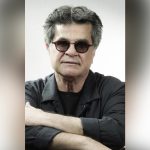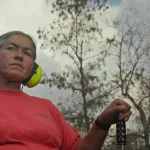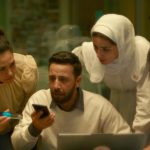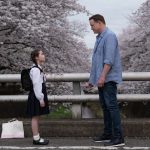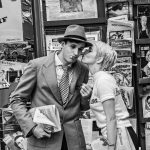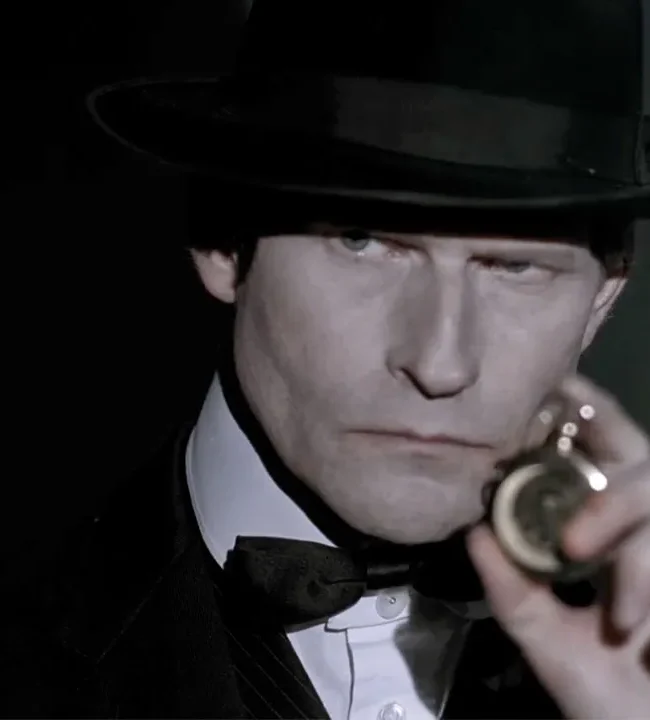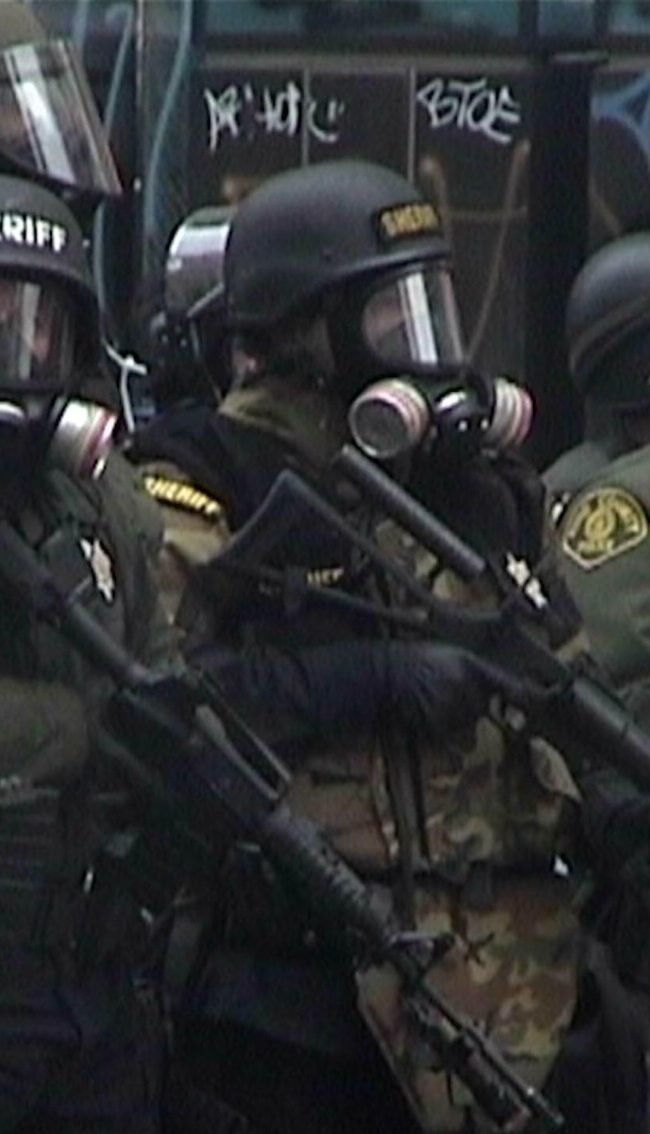A Conversation with Sasha Wortzel (RIVER OF GRASS)
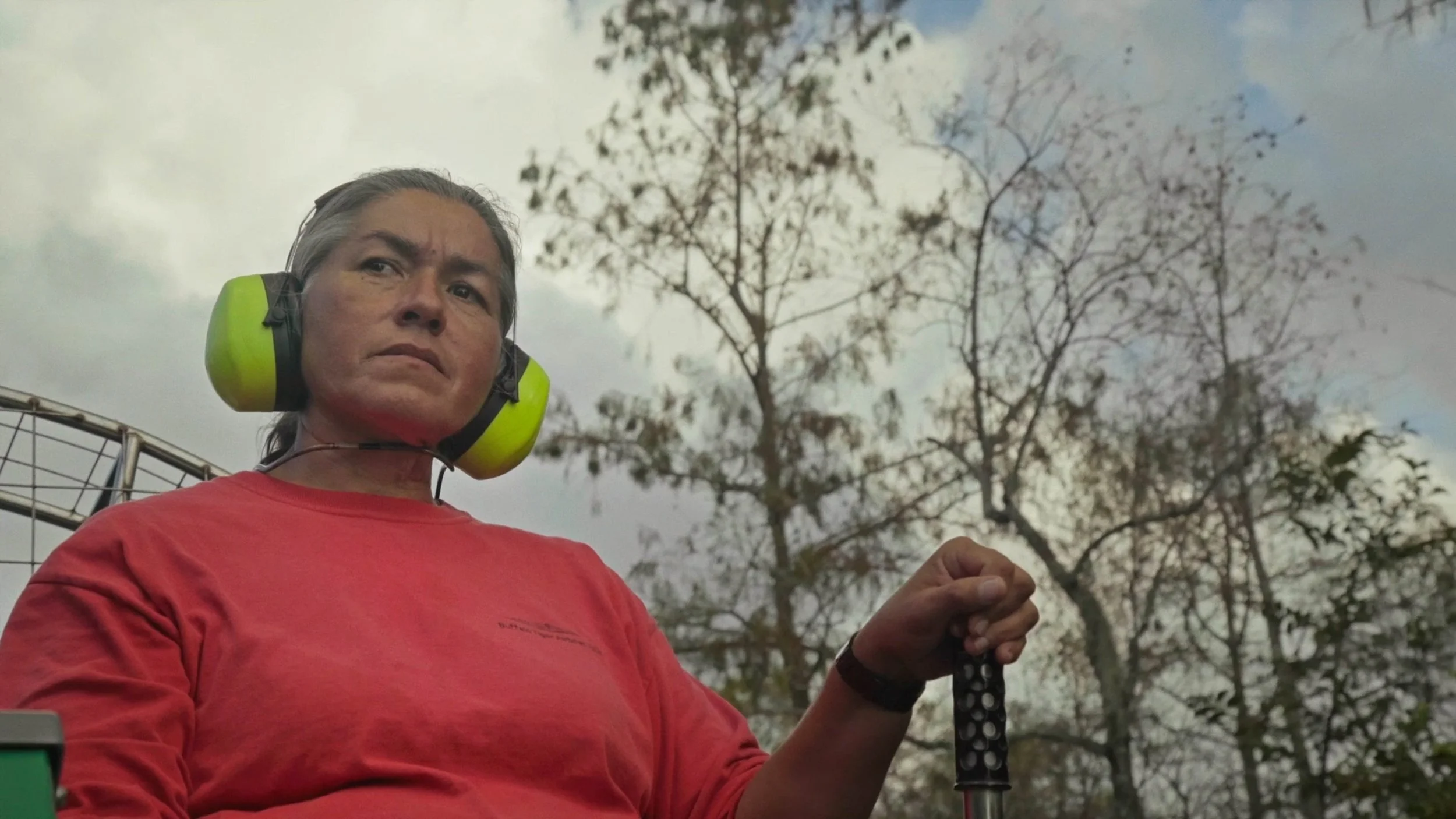
“Where’s my water? What did I do with the water?” a priest mutters, patting and digging into his pants pockets.
Standing on a fisherman’s dock, wearing a fedora and sunglasses hanging from his shirt pocket, he looks slightly out of place – more like a tourist than cleric. But as he begins his prayer, blessing “these boats, their equipment, and all who will use them,” and wishing their crews “a safe and productive season profitable for everyone,” the humor of this Florida-man scene takes a gloomy turn. In recent years, such dockside blessings have become increasingly frequent, as toxic fungal blooms, pollution, and harsh weather events threaten the life beneath Florida’s waters and, inevitably, the lives built around them.
River of Grass, Shasa Wortzel’s debut feature, takes a kaleidoscopic look into the history of violence in and against Florida’s Everglades. Wortzel dares audiences to move beyond stereotypes and misconceptions of Florida and join a collective rescue mission for one of America’s most unique ecosystems.
Part documentary, part personal essay, River of Grass weaves a time-bending conversation between Wortzel, author and ecologist Marjory Stoneman Douglas, and modern-day Floridians fighting for the health of their home. Wortzel’s own poetry, reflecting on her childhood growing up amongst the bewildering ecosystem of the Everglades, blends seamlessly into Douglas’ prose from her 1947 book “River of Grass.” Between their intertwined voices, Wortzel threads portraits of activists and environmentalists: an Indigenous leader guiding prayer walks along Florida’s Okeechobee river, a mother-daughter duo saving animals from carnivorous pythons unnaturally introduced to the ecosystem, an activist fighting against environmental racism.
These figures reveal the long history of the Everglades as both a refuge and a battleground. While activists’ achievements include blocking an airport from being built in the middle of the environment and establishing the Everglades National Park in 1947, land continues to be torn down and water impounded. While this development has led to the displacement of Indigenous communities and impose environmental harm against predominantly Black neighborhoods, the Everglades once served as a sanctuary for Indigenous people during the Seminole wars. The film portrays this cycle of destruction and salvation with lyrical precision
Much of the film is shot in an almost analog horror style, credited to the impressive and rare archival footage Wortzel unearths and her own grainy shots of Florida landscapes. This aesthetic recalls the disquieting feeling of found-footage horror, yet within the grain lies undeniable beauty. Perhaps that tension is the point – maybe we should be scared. With the recent construction of Alligator Alcatraz, an immigrant detention center built in the center of the Everglades, wetlands have been paved over, threatening chemical runoff into its waters. Still, Wortzel and the voices in her film offer a quiet plea: let’s not make this a ghost story.
River of Grass opens theatrically October 24, 2025 with a week-long run at New York City’s DCTV Firehouse Cinema.
Hammer to Nail: River of Grass came from a return to where you grew up after a long period of having left. You’re originally from Sanibel Island, in the Florida Everglades, until you moved to New York in 2005. After Hurricane Irma heavily damaged your home, you returned to the Everglades for an artists residency program, out of which this film came. This suggests that the idea of home – let alone the ecology that is tied to the word – has really gone back and forth for you, so what was your idea of Florida before, during, and after making this film?
Sasha Wortzel: I think a lot of folks who grew up in Florida share a sort of complex relationship with our home state. It’s a sort of love hate relationship. Some of that is driven by the ways that Florida gets stereotyped more broadly as a backwards, wacky Florida-man place. But those of us who grew up there, we can see that side and some of the difficulty of navigating the politics of Florida, and also the abundance of beauty there. I had that kind of complex relationship with Florida growing up and and then when I left, I really just longed for the beauty of the nature there and the water and the specific quality of the light and the heavy air, the humidity, the swing between the wet and dry seasons, the dramatic weather.
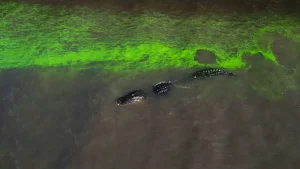
A still from RIVER OF GRASS
Coming back to make this film was really driven by a real sense of grief and sadness over watching the environment grow sicker and sicker, and watching these beautiful places that I’d found refuge in growing up disappear. The experience of making the film not only helped me find a way to process my grief and the complicated feelings about home, but to find a deeper sense of belonging there by getting to know all these different neighbors in the region and feeling like I was part of this much larger collective network of people who are caring for a place that’s frankly under siege in many ways. The experience of making the film was like finally spending time with or getting to know a distant relative who’d always been present in your life, yet you’d never really taken the time to fully get to know them and their stories. By the end of making this film, I felt like I just had this much deeper connection with Florida, as if it was like that relative. And I wound up living in Miami for several years while I was filming River of Grass.
The film was my day to day life and was infused in everything I was doing. It also allowed me to be involved in more movement building and organizing on the ground around protection for the Everglades, and to build deeper solidarities with many of the communities than participants that are featured in the film
HtN: How did you meet all of the characters involved in the film?
S.W.: Because I had arrived at my residency in the Everglades National Park right after Hurricane Irma, the phone lines were down, and there really wasn’t much reception in the park anyway, so I physically had to go out and find people. That was a very analog experience. So I would think, “I’d really love to get to know a hydrologist who’s taking water samples in the park.” And so I would like drive around or ride a bike around and find that scientist. Or I would asks folks who else I should meet, so it was a very organic snowballing process for finding participants.
Some of the people featured in the film, like the wildlife animal hospital that’s in the film, a place I volunteered in middle school, drew upon networks and relationships that I’d had from childhood. And I had known about Betty and her work because she had been doing these prayer walks and she had successfully stopped a bike path that was going to be built through the Everglades. So I just reached, she told me to come meet her at this airboat place that she runs, she had me get on her airboat and we talked all day, and at the end of that trip, she said that she was organizing a prayer walk where we would walk 120 miles around Lake Okeechobee — did I want to join? And so I did. Through those walks, I met a whole other network of people of from all walks of life across Florida, who are grappling with similar questions about their grief, about feeling overwhelmed by the amount of difficulties that we’re navigating, about the intensifying of all these things, about the sense of being disempowered, but what to do with that and how the act of gathering together and walking and witnessing the environment at this very intimate scale can be quite transformative.
HtN: Another character that takes a very central role in the film, while not present physically, is Marjory Stoneman Douglas. How did you find her work and what about her words struck you?
S.W.: I knew of Marjory’s work and “River of Grass,” and had read some of it in a joint literature and Environmental Studies class in college. But when I decided that I wanted to make a film about what was happening with the environment South Florida, I realized that her book was still the essential resource guide to the Everglades, and that that would be a very primary text to go to. As I read it, I was just so struck by one, the beauty of the poetry of it, but the way in which she explains this complex system – the ecology and the flow of water But it also is a story about people and place and culture and movements of resistance, so I was really struck by the way that she was weaving all these things. That’s when I thought it would be interesting to reimagine the book for for cinema. The book was also written in 1947 which was a really pivotal year in the life of the Everglades. It was the year where the Army Corps of Engineers and South Florida’s water management came together and built a whole bunch more infrastructure – levees, canals – to create more dry acreage for development and for farms. So I thought it would be interesting to breathe some life into her text and bring this book from the past into the future through cinema, and then to bring it to the present day through through these other voices and stories, and then it was later that she actually became a character in the film as well.
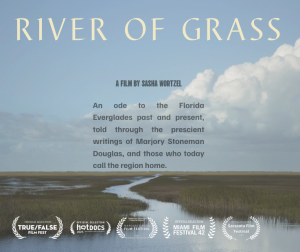
HtN: You are also a central character in the film, which makes this film part documentary part visual essay. How did you go about balancing how much of yourself to include or withhold from the film?
S.W.: Frankly, I really didn’t want to put myself in the film. I set out to make a film that would put Douglas’s book and passages from her book in conversation with people across the region. We actually had a whole assembly that didn’t include my voice. It was really during the editing process that it became evident that the film kind of needed a sort of container, and that that container should be me. My producer had pointed out that whenever I talked about the film or pitched the film, it was from this very personal place and this very deep sense of love for home. She and my co editor, Rebecca Adorno Dávila, really encouraged me to bring myself into the film. I spent some time, really after these walks with Betty, reflecting on my memories of home and and writing and generating the voiceover. And then it was through that voiceover that we really kind of found the weave of the different voices, and that revealed how much to use my voice and when and to define what my voice was doing differently than, say, the text from Marjory, or, the scenes with Betty Osceola, and what do those voices do when they’re brought together?
HtN: This film carries a theme found in some of your other works, that is the act of preservation, whether that be of physical places or people’s legacies. How, as a filmmaker, do you view and hold the responsibility of preservation and remembrance in your work?
S.W.: I’ve always been interested in sites, stories, figures who have been systematically excluded or erased or evicted from the historical record. I always approach my projects by trying to think about, how I bring a story to the surface and honor someone’s legacy, while also trying to sort of interrogate the very violent processes by which those stories or those people have been erased. My approach to preservation isn’t always necessarily straightforward, I think that’s why I’m often also really drawn to reimagining or repurposing archival material, whether that be an interview from the 1990s with the trans activist Sylvia Rivera on the waterfront of New York City, or or this text from a book from the 1940s it’s a questioning of how to bring that in conversation with the present to show that the present is always being inextricably shaped or haunted by the past, and that these things that may have been erased on the surface are actually still very present. So maybe it’s less about preservation, and more so letting those things rise and bob up to the surface of the water a little bit more. At the end of the day, rather than looking at or pointing a magnifying glass on what’s lacking or missing or broken, it comes from a place of trying to embrace that brokenness and see it as a source of strength.
HtN: Much of your work also focuses on stories of gender and queer identities, and while that isn’t explicitly on the surface of this film, I, at least see it in the subtext. Marjory often refers to the everglades as “they,” reflecting a personal yet collective identity to the ecosystem, and this can tie into to views of nature as a living identity that transcends gender or binary classifications. How do you see this theme present in this film, if at all?
S.W.: I grew up spending a lot of time in these wetland spaces and I’ve always felt really connected to them. In making this film, and in some of my more recent work, I have been thinking a lot about how wetlands, much like queer bodies, queer people, trans people, resist these sort of binary categories: wetlands are both land and water; sometimes the Everglades are very dry; during our dry season, you can walk across them, and other times they’re flooded and underwater. I think that there is a real relationship there. And in many ways, if you look at the kind of history of how wetlands have often been villainized or seen as spaces that need improvement because they don’t maybe produce capital easily, I think you can see a parallel, right with queer and trans bodies. I was also very moved by Marjory’s intentional use of the pronoun “they” in recognizing that the Everglades are not just one singular thing, they are a whole interconnected, interdependent network of ecosystems that all share the same water. That’s a really moving way to think about relationality in a broader sense in the world and I think that we queer people often make our own families and create less traditional kinship structures.
HtN: Finally, the Everglades have been a pertinent topic in the American consciousness, given the development of the detention center, Alligator Alcatraz. How would you relate that site to the topics discusses in River of Grass?
S.W.: Yeah, it’s wild, the timing of the film coming out and then this detention center being built in the center of the Everglades. I think in many ways the film is kind of a primer for this moment. It sort of tells the story of how we got to this moment of this awful detention center, cruelly known as Alligator Alcatraz. Our film specifically looks at this eerily parallel moment in 1969 when population was booming, tourism was really on the rise, and the state of Florida was looking for a place to build a new giant jet port that was meant to be four times the size of JFK airport. And they decided on a site in the Big Cypress in the middle of the Everglades, in the middle of where our flow of water is – our drinking water.
At that time, Marjory Stoneman Douglas, a bunch of other environmentalists, the Miccosukee Tribe, hunters, fishermen all came together and opposed that jet port, and they stopped it. It’s because of broad coalition building and that movement that we have what’s known as the Big Cypress National Preserve today. But it’s all under attack right now. The detention center is on that very same site. There’s the threat that we fought back against and thought was stopped 1969, 1970 is very much alive now this with this detention center. And the whole idea of incarcerating people and disappearing people in a place that has this history and this legacy of being a real site of refuge: a place to resist the Seminole Wars, a place of refuge against the removal of indigenous people, for people escaping slavery, and a place where a lot of queer communities take hikes together.
Everybody finds so much like peace and a real supportive environment there, so it’s really shocking to take that place and turn it into something as horrible as a detention center. While the film stops, before that happens, I think the film really helps set up this moment and speaks directly to it. Betty Osceola and many of the people in the film are on the ground organizing to stop this place and holding these really beautiful interfaith prayer vigils every Sunday outside the detention center. I do hope that the film, while not speaking directly to Alligator Alcatraz, I believe it can help amplify the movement and get people more connected to the environment and to each other and collective power we have when we do come together around a common kind of goal. We shut down the jet port, so we’re gonna shut this one down too.
– Kaitlyn Hardy

